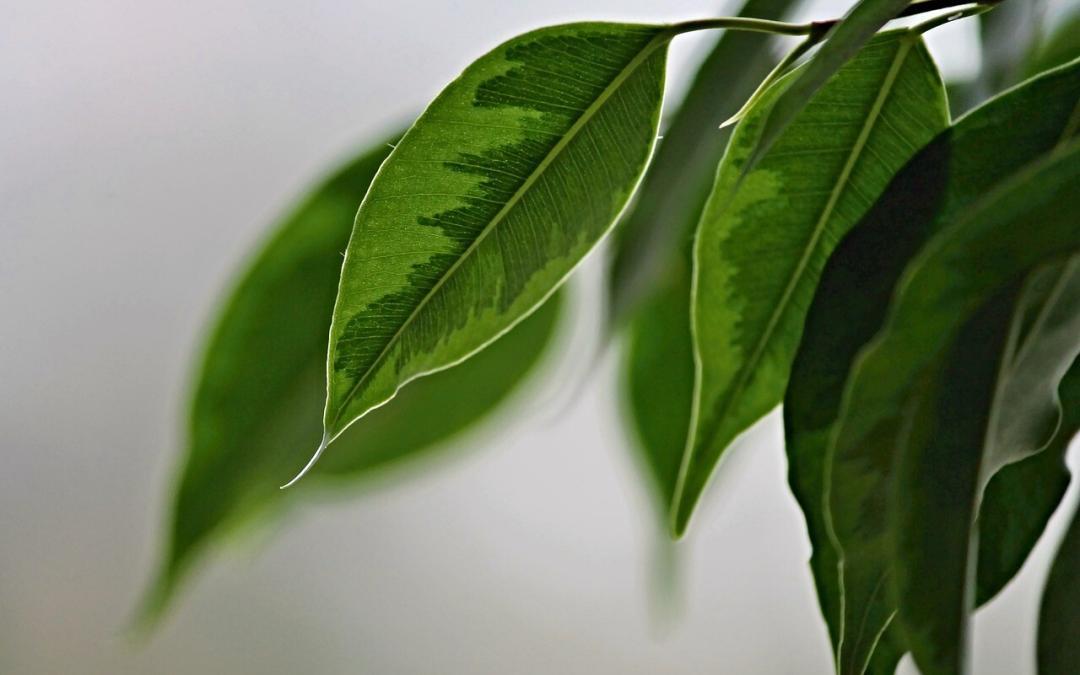My friend Danyelle and I were talking the other day and she mentioned that she inherited an indoor tree from a neighbor and wasn’t sure what it was, or how to care for it. Though she was thrilled that it had survived for an entire year without dying, it wasn’t thriving either. She hasn’t sent a picture yet, but it sounds like a ficus–the most common indoor tree.
The ficus is a member of the fig family, which has hundreds of cultivars, ranging from bonsai size to some growing well over thirty feet. The indoor varieties don’t bear fruit. They like bright, filtered light, but don’t like drafts or big temperature fluctuations, so keep them away from large windows, heat vents, and the like.
The most common complaints with the ficus is that the leaves turn yellow and drop off, though sometimes even young green leaves can fall off. The first complaint is usually caused by not enough water, the second can have several causes, but too much water is often the culprit. These plants don’t handle change well. If you move them to a new room with a different amount of light, or even repot them, you can stress the tree out, which can cause the leaves to fall off. When this happens, it is important to keep dead leaves cleaned off of the tree, and trim back any dead branches. Doing so will ensure the inner branches receive sufficient light. The change of seasons, including the air conditioner or heater starting to kick on can cause leaf loss as well.
You need to make sure the top inch or two of soil dries out between waterings and fertilize monthly with a half strength or slow release fertilizer during the growing season. If the plant is droppin leaves, don’t fertilize until it stops, and the growth slows during the winter, so do not fertilize during this period.
Anothe thing to watch out for is humidity,in most cases you’ll need to provide extra humidity for the tree. There are a couple of ways to do this. The first is to mist the tree twice a day with a spray bottle. The second–and the method I would use because I know I would forget the first–is to put your pot in a large tray filled with gravel. When you water, the extra water will flow into the gravel both keeping the roots from sitting in it–which your tree will appreciate–and creating a higher humidity zone for your tree. You could add water periodically to the tray itself if it dries out between waterings.
If youa re concerned about over or under watering, you can purchase a device that will indicate if the soil is too wet, damp, or needs watering.
And while you’re there, subscribe to our fantastic newsletter. In addition to being able to shop in the new virtual neighborhood, our newsletter brings you articles, products, services, resources and interviews from around the world—all with an LDS focus. Look for issues delivered to your email inbox every week on Monday, Wednesday, Friday, and Saturday.
Neighborhood Newsletter Subscriptions are FREE, and joining is easy.


Hi Heather,
Thanks for giving me a call last night. I was at a basketball game and it was far too late after I checked my messages to call you back. I grabbed the link. Thanks!
Candace
Heather,
Thanks for the low down on the lowly ficus. I’ve never had much luck with them … probably always overwatering!
If I ever decide to try another one, I’m calling you first! 🙂
OK – both of those trees are totally cute, but don’t look anything like my tree. I definitely have to send you a pic to see if you can identify it. Thanks for the info though! I really like the ficus tree better than whatever we have.